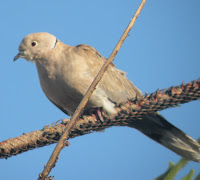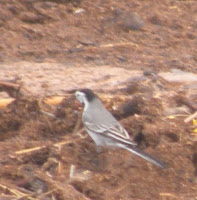In the town itself the most obvious birds were house buntings and yellow legged gulls. I saw house buntings inside my hotel. Shopkeepers ignore them or even feed them as they see them as sacred birds (see photo above). If you look more closely there are house sparrows and collared doves in the palms, white wagtails near the beach, chiffchaffs in the bushes and some wintering lesser black backed gulls overhead.
If you walk just south of the town on the coast road as I did there is maquis on either side (dense in places) until you reach the wadi mouth. This maquis is rich in birds. Common bulbuls (see photo below) are so noisy and common!
The maquis also houses warblers. The sardinian warblers were more open than usual as the males were courting females (see below). This open behaviour was even just after the rain in the morning as well as during the sunny afternoon. The blackcaps were more skulking. There were obviously quite a few chiffchaff and willow warblers too.
Several birds which are also found in northern Europe were present including wintering corn buntings and resident blackbirds.
Some birds not found in northern Europe were equally present such as desert grey shrikes (sub species algeriensis), a few north african chaffinches, flocks of spotless starlings, serins and spanish sparrows. A single female moussier's redstart was spotted in a dip in the landscape.
Inland by 150 metres from the coastal maquis there a wetter area. Some of the area has been drained into man made lakes. This attracted little ringed plovers by the waterside.The earth works also attracted thekla larks in an area otherwise apparent devoid of larks. And some of the pools had lesser black backed gulls among the yellow legged gulls.
Part of the area has not been drained. Here the waterlogged maquis held a few surprises. Not least was the presence of half a dozen spoonbills.There were also many cattle egret, a few little egret and 3 green sandpipers. In the air barn swallows and brown throated martins ( a new species for me) were flying endlessley.
After the waterlogged area I walked further south to the wadi mouth. Here I saw a kestrel flying overhead and a few black headed gulls among the yellow legged and lesser black backed gulls.
As I marched back to the hotel in the twilight I became increasingly embarassed by my flithy shoes which I came close to losing in mud trying to get pictures of the water birds earlier in the day.
The second day was very bright and sunny. I had no fears about my shoes. I walked north along the coast. The coast immediately north of the town has worn rocks and several same islands offshore. These held very large numbers of yellow legged gulls. I also saw a number of waders. There were plenty of turnstone and oystercatchers,a few grey plover and a single (non local) cormorant on the rocks.
If you walk far enough up the coast the rocks give way to sandy beach. I then moved inland about 100 metres and found another large tract of maquis. Many of the same species were seen as the day before - sardinian warblers were plentiful and so were common bulbul and serin (see below). I came across some new species for the trip too. I saw a beautiful male cirl bunting which evaded my camera. I got too greedy and tried to get too close - twice. To my shame I also saw my first african blue tit - not in Libya but there in Morocco.
There are large tracts of fresh water in the middle of this maquis. It looks a lot more permenant than the waterlogged land south of the town. There were many coots some of which were showing signs of nesting. Try as I might I could not make them into red knobbed coots. There were also several little grebe and a few moorhens.
As I turned towards the town to return I heard a loud scream behind me. A barbary partridge landed and seemed to announce that s/he wanted to be seen before I left. I duly took a photo then it flew off on cue.
Walking back to the hotel through the less fancy end of town that is the north I added pigeon to my list.
The journey back to Casablanca airport via an overnight stay in Marrakesh was not entirely uneventful. There were three more species for the trip. I saw plenty of little swifts in Marrakesh. This is another new bird (lifer) for me. On the train journey to Casablanca I noticed a pair of linnets at a railway station and several calandra lark in the fields on the way. This bird reminded me of my time in Azerbaijan where they were very common.
All in all I had a relaxing and enjoyable time in Morocco. I understand its appeal to birders. But I still prefer the Libyan challenge.
























No comments:
Post a Comment